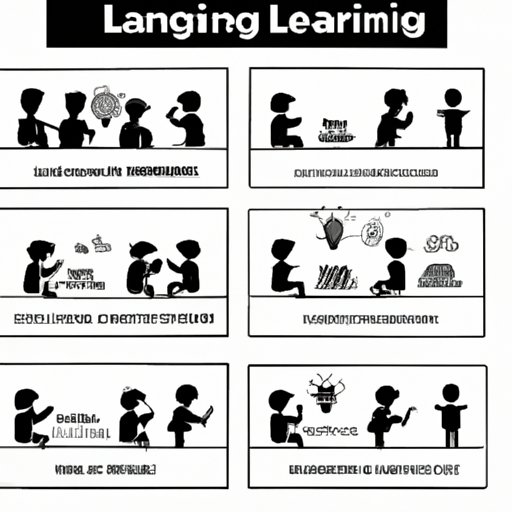
Introduction
Learning is a critical aspect of human development, enabling individuals to grow and adapt to changing environments. It occurs throughout our lives, from a young age to adulthood, and contributes to our professional achievements and personal interests. In this article, we explore the concept of learning in-depth and its importance in our lives. We explain the different types of learning, the processes involved, and the theories that guide our understanding.
Defining Learning: An Introduction to the Concept
Learning is the process of acquiring new knowledge, skills, and behaviors through experience, observation, and practice. It is central to human development, enabling individuals to adapt to the changing world around them.
There are three main types of learning: cognitive, emotional, and behavioral. Cognitive learning is concerned with acquiring knowledge and understanding, while emotional learning relates to developing emotional intelligence, managing emotions, and social skills. Behavioral learning focuses on acquiring practical skills and behaviors.
The process of learning involves various cognitive functions, including attention, memory, retention, and motivation. Attention involves focusing on the information, while memory involves storing and retrieving information. Retention relates to the ability to maintain information over time, while motivation is concerned with the drive to learn and achieve.
There are different theories of learning that guide our understanding, including behaviorism, cognitivism, and constructivism. Behaviorism suggests that learning occurs through conditioning, while cognitivism emphasizes the role of mental processes. Constructivism focuses on active learning, where individuals construct their knowledge from their experiences.
Why Learning is Essential to Human Development
Learning is critical to personal and professional growth, enabling individuals to achieve their goals and aspirations. It provides individuals with the skills and knowledge to adapt to changing environments and overcome challenges. Learning contributes to the growth of individuals, societies, and economies.
Adapting to changing environments is an essential aspect of human development. Learning enables individuals to adjust to changing circumstances and acquire new skills and knowledge. For instance, in the workplace, learning helps employees to develop new competencies and adapt to new technologies and practices.
Learning provides significant benefits to individuals and society, including improved health, greater civic engagement, and economic prosperity. For instance, learning enables individuals to understand health-related issues and adopt healthy behaviors, resulting in improved health outcomes. Also, learning enables individuals to participate actively in democratic processes, contributing to social cohesion and political stability.
From Kindergarten to College: The Evolution of Learning
Formal education has evolved over the centuries, from ancient times to the present. Early education in ancient civilizations was focused on religious and philosophical instruction, transmitting cultural values and beliefs. In modern times, education has become more formalized, with institutions such as schools and universities offering general and specialized education.
There are various approaches to education, including traditional, progressive, and Montessori. Traditional education is focused on transmitting knowledge, while progressive education emphasizes critical thinking and problem-solving. Montessori education emphasizes self-directed learning and hands-on experiences.
Technology has radically transformed education, enabling new ways of learning and teaching. Online learning, for instance, offers flexible and accessible education, while blended learning combines online and traditional learning methods, providing students with personalized and hands-on learning experiences.
Learning Beyond the Classroom: Real-World Applications
Lifelong learning is essential to personal and professional growth, enabling individuals to acquire new skills and knowledge throughout their lives. Learning can occur outside the traditional classroom setting, such as through apprenticeships, internships, volunteering, and personal interests. Lifelong learners are more adaptable and productive, with better career prospects and personal fulfillment.
Learning can also be applied to personal interests and hobbies, enabling individuals to explore new areas of interest and develop new skills. For instance, learning a new language can provide significant benefits, including improved cognitive functioning, cultural understanding, and career opportunities.
Neuroplasticity: How the Brain Changes through Learning
Neuroplasticity is the brain’s ability to change and adapt through learning. Learning can alter the structure and function of the brain, creating new connections and neural pathways. Neuroplasticity can be harnessed to improve learning outcomes, such as memory, attention, and cognitive functioning.
The factors that influence neuroplasticity include age, genetics, and environment. Younger individuals tend to have more plasticity than older individuals, while genetics can influence how quickly the brain responds to learning. The environment can also influence neuroplasticity, with exposure to enriched environments resulting in greater plasticity.
Examples of how neuroplasticity can be harnessed to improve learning outcomes include repetitive practice, gamification, and brain training exercises. These methods can improve memory, attention, and cognitive functioning, resulting in better learning outcomes.
Conclusion
In this article, we explored the concept of learning, including its types, processes, and theories. We discussed its importance in personal and professional growth, allowing individuals to adapt to changing environments and overcome challenges. We traced the evolution of formal education, discussing various approaches and the impact of technology on education. We also explored the real-world applications of learning and the concept of neuroplasticity. Finally, we highlighted the importance of continuing to learn and provided some actionable tips and resources for the audience.




